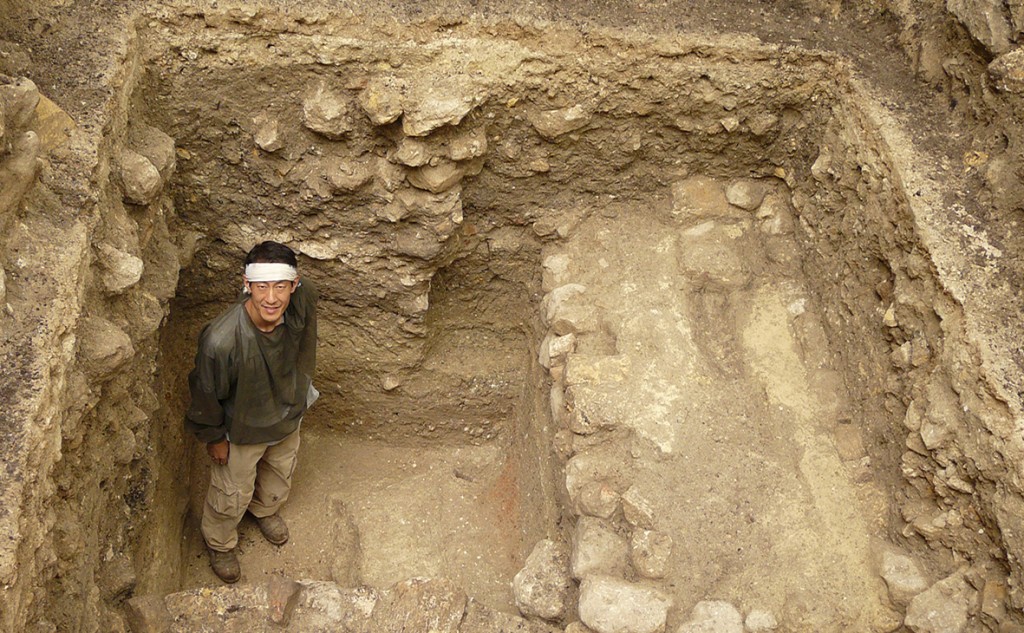危地马拉塞哇遗址的早期祭祀遗迹和玛雅文明起源
Takeshi Inomata 猪俣健 & Damien Bazy 达米安·巴兹
(University of Arizona 美国亚利桑那大学)
[soliloquy id=”1311″]
During the Early Middle Preclassic period (1000 to 700 BCE), sedentary communities and the earliest ceramics began to appear in the Maya lowlands. In other areas within Mesoamerica, many societies had settled into sedentary communities and began producing ceramics during the Early Preclassic period (approximately 2000-1000 BCE). The Gulf Coast Olmec of southern Veracruz and western Tabasco constructed a large center at San Lorenzo and were producing elaborate stone sculptures during the Early Preclassic. Scholars have long debated the influence that the Gulf Coast Olmec had on the development of lowland Maya society. Some argue that the Gulf Coast Olmec constituted a “mother culture”: the source of cultural innovations, including iconography and centralized political organization, that spread to the Maya and other Mesoamerican groups. Others contend that the lowland Maya received only limited Olmec influence or interacted with the Olmec as competing peers. Central to understanding this relationship is the development of formal architectural complexes consisting of plazas and pyramids, which eventually became the hallmarks of Mesoamerican civilizations. The spread of plaza-pyramid complexes across southern Mesoamerica during the Early Middle Preclassic period provides critical information regarding the origins of lowland Maya civilization and the role of the Gulf Coast Olmec in this development.
Excavations at Ceibal, Guatemala, conducted by Harvard University in the 1960s, revealed that the center was first occupied in the Early Middle Preclassic period. Building on Harvard’s investigations, in 2006 the Ceibal-Petexbatun Archaeological Project, directed by Takeshi Inomata, began carrying out more extensive excavations in Ceibal’s ceremonial center to expose the earliest occupation of the site. One of our primary concerns has been to refine Ceibal’s chronology through more precise stratigraphic control and extensive radiocarbon dating. In light of the newly-refined chronology, our research has revealed that an early “E-Group” architectural complex was first built around 1000 BCE. E-groups consist of a western pyramid and a long eastern platform and are characteristic of Middle Formative centers in the state of Chiapas, Mexico. The E-group at Ceibal predates all other known examples found in Chiapas, at lowland Maya centers, and at the Olmec center of La Venta. That is not to say that Ceibal’s E-group was the first ever built, or that it was a purely Maya invention. The founders of Ceibal were undoubtedly in contact with settlements in nearby Chiapas, and foundational caches of greenstone axes in the Ceibal E-group show a connection to the Gulf Coast Olmec.
In addition to refining the chronology of the Early Middle Preclassic constructions at Ceibal, it is important to consider the social roles that these buildings and spaces played in specific historical contexts. The data from Ceibal make it clear that the original ceremonial complex was built as a stage for communal ritual performances. Instead of gradually transitioning from a small village to a ceremonial center, the residents of Ceibal built a formal public space as soon as they adopted a sedentary way of life. Numerous offerings, including greenstone axes, were deposited in the E-group plaza throughout the Middle Preclassic period, indicating that this space remained the primary stage for communal ritual.
New data from Ceibal suggest that the development of lowland Maya civilization did not result from unidirectional influence from the Olmec center of La Venta, but rather from interregional interactions involving groups in the southwestern Maya lowlands, Chiapas, the Pacific Coast, and the southern Gulf Coast. Ceibal was not a passive recipient of an idea established elsewhere, but rather participated actively in a process of innovation. During the Late Middle Preclassic period (700-400 BC), Ceibal maintained its original formal plaza, but in terms of construction methods and ceramics, the site was more closely affiliated with the rest of the Maya lowlands than with Chiapas and the Gulf Coast.
前古典时期中间阶段早期(公元前1000-700年),定居人群和最早的陶器开始出现于玛雅低地。在中美洲的其它地区,许多人群在前古典时期早期(约公元前2000-1000年)已经定居下来,并开始制作陶器。前古典期早期,韦拉克鲁斯南部和塔巴斯科西部墨西哥湾沿岸的奥尔梅克人在圣洛伦索建造了一座巨大的礼仪中心,并且制作生产精美的石雕像。长期以来,学者们一直讨论墨西哥湾沿岸奥尔梅克文化对于低地玛雅社会发展的影响。有观点认为,墨西哥湾沿岸奥尔梅克人是玛雅文化的母体,其图腾、中央集权政治组织等一系列文化创举传遍玛雅和和其他中美洲群体。而另一些学者提出,低地玛雅受到奥尔梅克文化的影响很小,或者他们与奥尔梅克文化之间只是竞争的关系。作为中美洲文明标志的广场和金字塔等建筑群,是理解玛雅文化与奥尔梅克文化关系的关键。前古典时期中间阶段见于整个中美洲南的广场、金字塔建筑群为研究低地玛雅文明起源以及在此过程中墨西哥湾奥尔梅克文化所起的作用提供了重要信息。
20世纪60年代,哈佛大学主持发掘了危地马拉塞哇遗址。发掘资料显示,该中心建立于前古典时期中间阶段早期。在此基础上,从2006年起,猪俣健主持塞哇考古项目,开始对塞哇礼仪中心进行更进一步的发掘以揭示该遗址的最早使用期。此项目首要目的之一,便是依靠更精确的地层控制和更多的放射性碳素年代分析数据来改进塞哇遗址年表。根据这张重新修改过的年代表,早期的“E-组”考古学建筑群首次建于在公元前1000年。E组建筑群的西部是一座金字塔,东部是一长条形平台,带有典型的墨西哥帕恰斯中形成时期中心的特征。塞哇E组建筑早于所有其他已知的低地玛雅中心帕恰斯和奥尔梅克中心拉文塔所见的同类建筑群。这并不意味着塞哇E组建筑是这类建筑群中最早的,也不是说这种建筑群完全是由玛雅人发明的。毫无疑问,塞哇的建立者与附近帕恰斯聚落有交流,例如,E组建筑下的窖藏中出土的绿岩斧表现出与墨西哥湾沿岸奥尔梅克文化的联系。
此外,这些建筑与空间在特定历史背景中起到的社会作用也是十分重要的研究问题。塞哇的资料说明,这种最初的礼仪建筑群是作为公共仪式举行场地而建立的。而且,塞哇不是慢慢地由一个小村庄变为一个礼仪中心,而是在其居民选择了定居的生活方式之后,就立即建造了公共仪式建筑。在前古典时期中间阶段早期,包括E组建筑广场下出土的绿岩斧在内的大量祭品的发现,说明该空间主要用于公共礼仪活动。
塞哇遗址的新发现表明,低地玛雅文明并不是由奥尔梅克文化中心拉文塔直接发展而来,而是由玛雅低地西南部、帕恰斯、太平洋沿岸以及墨西哥湾沿岸南部等地区的文化相互交融而形成的。塞哇并不是被动接受其他文明的思想,而是积极地参与了创新的过程。在前古典时期中间阶段晚期(公元前700-400年),塞哇的广场保持了最初的形式,但其建造方法和陶器风格方面,未见来自帕恰斯和墨西哥湾沿岸地区的强烈影响,却更多地表现出与玛雅低地其地区之间的联系。
Biographical Sketch 简历
Takeshi Inomata earned his Ph.D. in Anthropology from Vanderbilt University in 1995. He has worked in the La Entrada region in Honduras and Aguateca and Ceibal in Guatemala. His publications include The Classic Maya (with Stephen Houston, 2009, Cambridge University Press), Archaeology of Performance: Theaters of Power, Community, and Politics (with Lawrence Coben, 2006, AltaMira Press), and Early Ceremonial Constructions at Ceibal, Guatemala, and the Origins of Lowland Maya Civilization (Science 340:6131).
猪俣健于1995年获得美国田纳西大学人类学博士学位。他曾在洪都拉斯圣罗莎地区以及危地马拉的奥哥提卡和赛巴尔地区工作。他出版的著作有:《古典时期的玛雅》(与斯蒂芬·霍斯顿合著,2009年,剑桥大学出版社),《表现考古学:剧院的权力、社团和政治》(与劳伦斯·科本合著,2006年,阿尔塔米拉出版社),以及《危地马拉塞哇早期的礼仪性建筑和低地玛雅文明的起源》(《科学》第340卷6131页)。
Damien Bazy graduated from the University of Paris 1 where he defended his dissertation titled The Relation between Public and Private Places in the Central and Southern Lowlands Maya Cities from the Preclassic to the Terminal Classic. His investigations focus primarily on analyzing public and private places, considering them inscribed in a set of spatial relationships, and examining the material, immaterial and ideal forms established by a given society at a given time to express given relationships between distinct social groups. His research is firmly positioned in what might be considered a sociology of Classic Maya societies in Mesoamerica. As a member of the Ceibal-Petexbatun Archaeological Project since 2012, he is currently a visiting scholar at the
School of Anthropology, University of Arizona, Tucson, AZ.
达米安·巴滋毕业于巴黎第一大学,毕业论文是《前古典时期到古典时期末期低地玛雅城市中部和南部地区公共及私人空间的联系》。主要研究方向是将公共、个人空间分析,材料研究,以及并研究特定时期内一个特定社会在不同群体之间的特定关系的物质、非物质和意识形态。他长期从事于中美洲古典玛雅社会的社会学问题研究。从2012年起,他成为Ceibal-Petexbatun 考古项目成员之一,目前他是亚利桑那大学人类学系访问学者。

